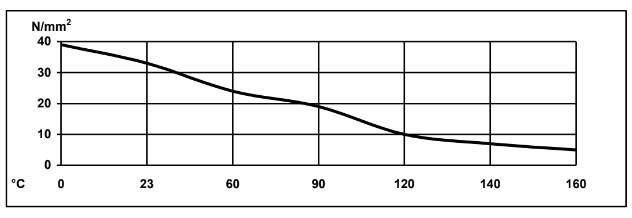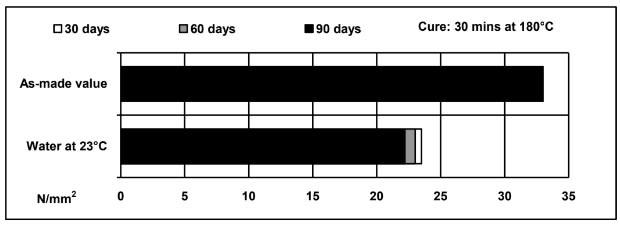Enhanced TDS
Identification & Functionality
- Chemical Family
- Function
- Epoxy Adhesive,Structural Adhesive
- RTU Product Type
- Technologies
- Product Families
Features & Benefits
- Ready-to-Use Product Features
- Key Properties
- Cures at 150-200°C
- Heat resistant to 160°C
- Very good peel strength
- Good chemical resistance
- Exceptionally good impact strength at temperatures down to -40°C.
Applications & Uses
- Compatible Substrates & Surfaces
Properties
- Physical Form
Regulatory & Compliance
- Certifications & Compliance
- Chemical Inventories
Technical Details & Test Data
- Typical Cured Properties
Unless otherwise stated, the figures given below were all determined by testing standard specimens made by lap- jointing 115 x 25 x 1.5 mm strips of aluminium alloy. The joint area was 12.5 x 25 mm in each case. The figures were determined with typical production batches using standard testing methods. They are provided solely as technical information and do not constitute a product specification.
Average lap shear strengths of typical metal-to-metal joints (ISO 4587)
Cured for 30 min at 180°C and tested at 23°C
Pretreatment - Sand blasting + degreasing

Mechanical properties (typical average values)
Tensile strength (ISO 527-2)
(cured 30 minutes at 180°C) ca.60 MPa
Elongation at break ca. 6%
E - modulus ca. 2-2.5 GPa
Lap shear strength versus temperature (ISO 4587) (typical average values)
Cure: 30 min at 180°C

Glass transition temperature (ISO 11357-2)
Cured 30 min at 180°C ca. 110-115°CLap shear strength after immersion in water at 23°C (typical average values)
Cure: 30 min at 180°C
- Processing Information
Pretreatment
- The strength and durability of a bonded joint are dependant on proper treatment of the surfaces to be bonded.
- At the very least, joint surfaces should be cleaned with a good degreasing agent such as acetone or other proprie-
- Tary degreasing agents in order to remove all traces of oil, grease and dirt.
- Low grade alcohol, gasoline (petrol) or paint thinners should never be used.
- The strongest and most durable joints are obtained by either mechanically abrading or chemically etching (“pickling”) the degreased surfaces. Abrading should be followed by a second degreasing treatment.
Application of adhesive
- The resin/hardener mix is applied with a spatula to the pretreated and dry joint surfaces.
- A layer of adhesive 0.05 to 0.10 mm thick will normally impart the greatest lap shear strength to the joint.
- The joint components should be assembled and clamped as soon as the adhesive has been applied. An even con-
- tact pressure throughout the joint area will ensure optimum cure.
Mechanical processing
- Specialist firms have developed metering, mixing and spreading equipment that enables the bulk processing of adhesive.
- We will be pleased to advise customers on the choice of equipment for their particular needs.
Equipment maintenance
- All tools should be cleaned with hot water and soap before adhesives residues have had time to cure. The removal of cured residues is a difficult and time-consuming operation.
- If solvents such as acetone are used for cleaning, operatives should take the appropriate precautions and, in addition, avoid skin and eye contact.
Curing Times
Temperature °C 160 180 200 Cure time minutes 40 30 20 Lap shear strength at 23°C N/mm² 30 - 35 30 - 35 30 - 35 - Note: Temperatures below 150°C will not give adequate cure even when cure time is prolonged.
- The adhesive may exotherm in thick bondlines. Bondline thickness should not exceed 2 mm.
Safety & Health
- Handling Precautions
Our products are generally quite harmless to handle provided that certain precautions normally taken when handling chemicals are observed. The uncured materials must not, for instance, be allowed to come into contact with food- stuffs or food utensils, and measures should be taken to prevent the uncured materials from coming in contact with the skin, since people with particularly sensitive skin may be affected. The wearing of impervious rubber or plastic gloves will normally be necessary; likewise the use of eye protection. The skin should be thoroughly cleansed at the end of each working period by washing with soap and warm water. The use of solvents is to be avoided. Disposa- ble paper - not cloth towels - should be used to dry the skin. Adequate ventilation of the working area is recom- mended.
- Handling Precautions
Our products are generally quite harmless to handle provided that certain precautions normally taken when handling chemicals are observed. The uncured materials must not, for instance, be allowed to come into contact with food- stuffs or food utensils, and measures should be taken to prevent the uncured materials from coming in contact with the skin, since people with particularly sensitive skin may be affected. The wearing of impervious rubber or plastic gloves will normally be necessary; likewise the use of eye protection. The skin should be thoroughly cleansed at the end of each working period by washing with soap and warm water. The use of solvents is to be avoided. Disposa- ble paper - not cloth towels - should be used to dry the skin. Adequate ventilation of the working area is recommended.
Storage & Handling
- Shelf Life Information
ARALDITE® AV 4900 may be stored for up to 2 years at 2 - 8°C. At 15-25°C the life of the product is 6 months after removal from storage at 2 - 8°C.
Other
- Appearance
- Milky / yellowish
- Color (SDS)
- Milky Yellow
- Odor (SDS)
- None
- Physical Properties
Value Units Test Method / Conditions Lap Shear Strength1 min. 30.0 MPa MPa at 25°C Specific Gravity 1.2 - Viscosity2 200.0-300.0 Pa.s Pa.s
